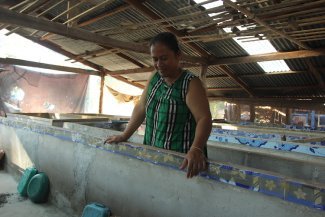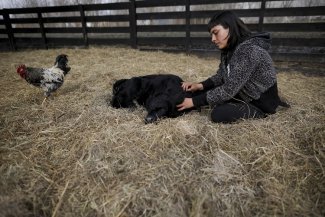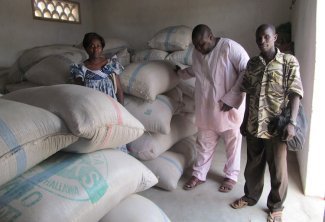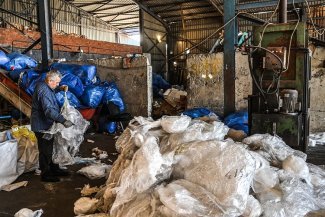The industry’s current focus is on feeding insects to animals. According to the Dutch financial services company Rabobank, the biggest market is currently pet food but is set to be overtaken in the next few years by aquaculture.
In his public appearances, Robert Downey Jr. seems strikingly similar to the character he plays in the Marvel movies. In an interview with The Late Show host Stephen Colbert last February, he took a few minutes to talk about insects. The actor made an impassioned case for mealworm larvae flour made by French company Ynsect, a product he provided for Colbert to show off during a special broadcast following last year’s Superbowl:
— “What is this? This looks like I could make cocoa with this,” Colbert joked upon seeing the brown colour of the flour.
— “That’s an insect-based premium protein, it’s made from [tenebrio] molitor, which is mealworm larvae […]. It’s just been approved by the EU for human consumption,” the actor replied with the visionary confidence of an Iron Man.
— “You’re not just getting me to eat dirt, are you?” Colbert said.
During the interview, Downey Jr. argued that insect-based products represent a major breakthrough for reducing greenhouse gas emissions. Beyond the altruistic ambitions of the man who portrays Tony Stark, recent years have seen increased investments in pioneering companies in the insect industry, which are preparing to increase their production.
One of them, Ynsect, last year announced that Footprint Coalition, an initiative founded by Downey Jr. to invest in venture capital for innovative and sustainable businesses, had together with other investors committed US$372 million (€330 million) to finance the construction of a huge mealworm farm in Amiens, France.
According to a recent report by Dutch bank Rabobank, demand for insect protein will increase fifty-fold over the next decade, from an estimated 10,000 tonnes produced last year to half a million tonnes by 2030.
While Downey Jr. was talking about human consumption, the industry’s current focus is on feeding insects to animals. According to Rabobank, the biggest market is currently pet food but is set to be overtaken in the next few years by aquaculture, the main growth areas of the fledgling industry.
According to an email from the International Platform for Insects as Food and Feed (IPIFF), which represents the interests of producers in Europe: “The benefits of insect farms are attracting investors as they contribute to achieving the European Green Deal and the objectives of the Farm to Fork strategy, such as the transition to climate neutrality, the diversification of agriculture and the integration of sustainable and healthy diets.”
Europe’s legislative machinery has been set in motion. Last May, the European Commission approved the sale for human consumption of tenebrio molitor, the first of seven species that have been proposed by companies as “novel foods.” In August, the Commission approved the use of processed insect proteins to feed pigs and poultry, which according to IPIFF account for 65 per cent of the compound feed market in the EU. “It’s part of the Farm to Fork strategy, which aims, among other things, to promote a more sustainable production system,” a European Commission spokesperson told Equal Times.
Proponents of insect proteins, which are rich in fatty acids, fibre and micronutrients, argue that they offer an alternative to the soya that Europe imports from tropical areas affected by deforestation, such as the Amazon. Some critical voices, however, argue that they would barely make a dent in the enormous impact of intensive livestock farming.
But with legislators and investors in the same boat, the wind is blowing in favour of insect farmers in Europe. The question now is: how far can they go?
A nascent industry
Just outside the city of Salamanca in inland Spain, the Spanish company Tebrio is preparing to take a major step with the construction of a 70,000 square metre complex for mealworm breeding, to be completed by 2024.
“Right now we [European insect companies] are all in the same boat. We’ve proven our technologies and we’re introducing our products to the market in small quantities,” says Tebrio co-founder and CEO Adriana Casillas.
The 2017 reform to European legislation allowing for the use of processed insect protein in aquaculture was a turning point for many companies. Casillas, who is also president of IPIFF, speaks of a “difficult technological birth over just a few years”. European companies, almost all founded over the last decade, have become a hotbed of R&D ensuring that products get to the market as quickly as possible.
But the exponential growth expected over the next decade will not provide miraculous solutions. “The promise of insects is not that they will displace any other raw material but that they will complement significant future demand for protein,” explains Casillas.
According to the Rabobank report, the most optimistic growth projects have insect protein accounting for 1 per cent of feed in fish farms by 2030. “There’s room for all of us and many more, because we are talking about a truly massive market,” she says.
This precipitous expansion also poses a risk, as demonstrated last February when the Insect Technology Group went into administration in the UK. The company, which was founded in 2008 and in 2012 received support from the Bill and Melinda Gates Foundation, had planned to build 200 factories over ten years before getting into financial trouble.
The high cost of insect protein currently makes it a premium product. And while large-scale production will see prices drop, the success of these companies will depend largely on their ability to sell and to demonstrate the virtues of their products, as well as the future achievements of R&D departments.
According to Rabobank’s research, these factors, along with legislation and investor support, will be necessary to transforming insect protein from “a niche marketing tool to an established ingredient valued for its functional benefits”.
Cows stacked 150 metres high
One of the advantages of insect farming is that it uses less land and natural resources to produce more tonnes of protein than traditional farms and thus has a smaller carbon footprint. “We can raise animals vertically. We could never imagine raising cows in a skyscraper, even though it could be done, but it would be much more difficult to manage cows stacked 150 metres high than insects stacked 15 metres high,” says Tebrio co-founder and technical director Sabas de Diego.
Among the species that dominate the market are the mealworm, the black soldier fly and the house cricket. Like the other species, tenebrio molitor is used for circular production: its dung is made into fertiliser and its exoskeleton is used to extract chitin, which has multiple industrial applications.
According to de Diego, insect protein can potentially help to prevent overfishing, as much fish food is caught at sea. Tebrio’s research also shows that supplementing animals’ diets with tenebrio molitor improves their health. “The animal’s immune system and gastric system function better,” says de Diego.
The next frontier for insect breeders is the reuse of food waste and other waste from our food production system. IPIFF claims that up to a third of the food waste generated today can be used for substrate.
Current European regulations, which became stricter following the ‘mad cow’ crisis in the 1980s and 1990s, prohibit the reuse of waste from hotels, restaurants and households. But a favourable opinion by the European Food Safety Authority in 2015 may pave the way for legislative reforms.
According to Reyes Tirado, a researcher at Greenpeace’s science unit, the direct consumption of insects to reduce dependence on intensive livestock farming is necessary from an environmental point of view. “With every step we take from vegetable protein to insect protein, to poultry or pork protein, we are losing efficiency,” says Tirado.
Tirado is critical of those who claim that insects will solve the world’s food security problems: “Protein deficiency is a very localised problem in very specific regions.” Using insects to feed animals solves “a first world problem in countries where a lot of industrial livestock is produced and a lot of feed is imported, especially soya that comes from tropical countries,” she says. More important is “the amount of meat that would be sustainable in Europe”; this is an angle that is missing from the EU’s Farm to Fork strategy, as Tirado points out.
While Europeans may remain wary about integrating insect consumption into their diets, changes to the animal feed and food market may be the first step towards changing their minds.













